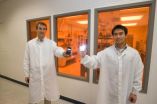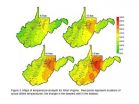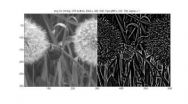(Press-News.org) Today's Oct. 4 issue of the high-impact journal, Applied Physics Letters, contains a new electrofluidics design from the University of Cincinnati and start-up company Gamma Dynamics that promises to dramatically reshape the image capabilities of electronic devices.
This patent-pending electrofluidics breakthrough by the Novel Devices Laboratory at the University of Cincinnati and partner companies Gamma Dynamics, Dupont and Sun Chemical follows about seven years of work. According to lead researcher Jason Heikenfeld, UC associate professor of electrical and computer engineering in the College of Engineering & Applied Science, and John Rudolph, president of Gamma Dynamics, the breakthrough is even more impressive when you realize that similar research efforts elsewhere have lasted a decade without achieving similar results.
Importantly, this new "zero power" e-Design from UC can be manufactured with existing equipment and technology.
Said Heikenfeld, "What we've developed breaks down a significant barrier to bright electronic displays that don't require a heavy battery to power them."
He explained that, currently, electronic devices fall into two basic camps. The first includes those devices that offer limited function and slow speed but require little power to operate. These would include e-readers like the Kindle.
In the second camp, devices like cell phones, laptops and the iPad provide high color saturation and high-speed capability for video and other functions but at a cost of high power usage.
Heikenfeld stated, "Conventional wisdom says you can't have it all with electronic devices: speed, brightness and low-cost manufacturing. That's going to change with the introduction of this new discovery into the market. This idea has been in the works for a while, but we did not start really pushing the project until we thought we could make it manufacturable."
A NEW DESIGN THAT MAKES USE OF REFLECTION
Before describing UC's new "zero-power" design, it's helpful to understand the basic design of existing electronic devices.
Think of an e-reader as a bunch of micro-sized buckets (or pixels) of mixed black and white paint, where you can move the black and white pigments to the top or the bottom of the bucket. Just like mixing paint, the process is not fast. That's somewhat close to how today's e-readers work. The slow movement of these particles forms the text and grayscale images you see on an e-reader. These devices use practically no power unless you are switching the screen. It's actually making use of ambient light to make the particles visible. When the user turns the device on or off or switches a page, he's electronically "mixing the paint" (or pixels) to create the overall image or text page.
Faster, color-saturated, high-power devices like a computer's liquid-crystal display screen, an iPad or a cell phone require high power, in part, because they need a strong internal light source within the device (that "backlights" the screen) as well as color filters in order to display the particles as color/moving images. The need for an internal light source within the device also means visibility is poor in bright, natural light.
The new "zero-power" design combines the best features of both these kinds of devices. It requires low-power because it makes use of ambient light vs. a strong, internal light source within the device. As such and because of its low-power requirements, this new technology will make for more environmentally friendly electronic devices, stated Heikenfeld.
Yet, even though an electronic device with this eletrofluidic technology would lack a strong, internal light source, it would still display bright images at high speed. How?
Behind the display screen are two layers of liquid (oil and a pigment dispersion fluid like an inkjet fluid). Between the two layers are reflective electrodes. Think of these electrodes as a highly reflective mirror.
Ambient light enters through the display screen and through the first layer of liquid and hits the reflective electrodes. When the light hits that reflective electrode, it bounces back out to the viewer's eye, creating the perception of a bright, color-saturated image…or text or video… .
A small electric charge powers the movement of these oil and pigment-dispersion liquids. The movement occurs between a bottom layer behind the reflective electrodes and a top layer in front of the reflective electrodes. When the pigmented substance is positioned in the "top" layer (sandwiched between the ambient light and reflective electrodes), it creates a reflected ray of colored light which combines with literally millions of ambient light rays to produce a full-color display.
(The closest competition with similar brightness is electrochromic technology, which does not switch quickly enough to create video images. And the closest competition that is really low power but can still "do" video is called "Mirasol" technology developed by Quallcomm. However, when trying to display a color like white, the "Mirasol" technology has about one-third the brightness level of the UC technology being announced today. "Mirasol," in fact, resembles greyed newsprint.)
THIS NEW TECHNOLOGY IS MANUFACTURABLE WITH CURRENT FACILITIES AND EQUIPMENT
Importantly, the new e-Display design published today is manufacturable with current facilities and technology.
Manufacturability using the same equipment as that used for current LCDs was essential since a new LCD plant costs around $2 billion.
WHEN WILL THIS TECHNOLOGY BE AVAILABLE TO CONSUMERS
According to Gamma Dynamics' Rudolph, this electrofluidics breakthrough will change the display technology used in a myriad of electronic devices. e-Readers like the Amazon Kindle will be able to display color and video. Devices like cell phones and iPads will require much less power and will be readable even in bright sunlight.
He estimated consumers will likely first see it in action as grocery-store shelf labels and advertising displays in about three years' time.
Currently, liquid-crystal displays are attached to some grocery-store shelves, providing product and price information. These run on battery power; however, the batteries are insufficient to meet the LCDs' high power requirements. So, their brightness levels are insufficient to attract shoppers' attention. Stores still attach paper labels to them in order to indicate sale items or barcodes with eye-catching brightness.
Rudolph said that by substituting the UC-developed electrofluidic e-Display technology, these shelf-label devices would become bright and eye-catching. Given the frequency with which shelf labels are updated, the store labels should then operate for at least five years without the need for battery replacement.
INFORMATION:
RESEARCH SUPPORT
As mentioned, Gamma Dynamics, Dupont and Sun Chemical partnered with UC in this research. Partial support was also provided by grants from the National Science Foundation, the Army Research Laboratory and the Air Force Research Laboratory.
Breakthrough e-display means electronics with high speed, high readability and low power usage
2010-10-06
ELSE PRESS RELEASES FROM THIS DATE:
Fish oil linked to increased risk of colon cancer in mice
2010-10-06
EAST LANSING, Mich. — Fish oil – long encouraged by doctors as a supplement to support heart and joint health, among other benefits – induced severe colitis and colon cancer in mice in research led by Michigan State University and published this month in the journal Cancer Research.
Jenifer Fenton, a food science and human nutrition researcher at MSU, led the research that supports establishing a dose limit for docosahexaenoic acid (DHA), one of the omega-3 fatty acids present in fish oil, particularly in people suffering from chronic conditions such as inflammatory bowel ...
'Paradigm shift' in how physicians treat peripheral artery disease
2010-10-06
A balloon angioplasty device that sucks up dangerous plaque debris could trigger a "paradigm shift" in how physicians treat peripheral artery disease, researchers write in the current issue of Endovascular Today.
"We will see a shift in how we treat lesions," write Dr. Robert Dieter of Loyola University Health System and Dr. Aravinda Nanjundappa of West Virginia University.
In two clinical trials totaling 123 patients, the device had a success rate of 97 percent to 99 percent and consistently outperformed filter devices typically used to capture debris particles, Dieter ...
Shortfalls in carotenoid intake may impact women's health
2010-10-06
GRAND RAPIDS, MICH., Oct. 5, 2010 – Only about a third of American women are meeting their fruit and vegetable intake recommendations, which means they are likely missing out on potentially important breast and ovarian health benefits (1). Along with vitamins, minerals and fiber, fruits and vegetables contain a type of phytonutrient called carotenoids, which research suggests help support women's health including breast and ovarian health.
Based on a new report called America's Phytonutrient Report: Women's Health by Color, older women have total carotenoid intakes ...
ORNL uses new technologies to take steam out of wasted energy
2010-10-06
OAK RIDGE, Tenn., Oct. 5, 2010 -- By installing wireless sensors and replacing faulty traps along the 12 miles of steam lines at Oak Ridge National Laboratory, officials expect to save as much as $675,000 per year.
With 1,600 steam traps, which normally open slightly to discharge condensed steam with a negligible loss of live steam, the problem occurs when a trap fails and that failure goes undetected and unrepaired, said Teja Kuruganti, a member of the Computational Sciences and Engineering Division.
Manual inspections of each trap is a daunting and sometimes dangerous ...
SMU geothermal mapping project reveals large, green energy source in coal country
2010-10-06
DALLAS (SMU) – New research produced by Southern Methodist University's Geothermal Laboratory, funded by a grant from Google.org, suggests that the temperature of the Earth beneath the state of West Virginia is significantly higher than previously estimated and capable of supporting commercial baseload geothermal energy production.
Geothermal energy is the use of the Earth's heat to produce heat and electricity. "Geothermal is an extremely reliable form of energy, and it generates power 24/7, which makes it a baseload source like coal or nuclear," said David Blackwell, ...
Sediment pollution should be included in water quality assessment
2010-10-06
Under the Water Framework Directive (WFD) (Directive 2000/60/CE), member states are required to achieve Good Water Status for water (continental, estuarine, subterranean and coastal water bodies) in Europe by 2015. Surface water quality is assessed taking into account the ecological and chemical status.
The quality of aquatic systems is more accurately assessed using the status of both the water column and the underlying sediment. A recent study by researchers of AZTI-Tecnalia concluded that water bodies risk being misclassified if, on evaluating their chemical status, ...
New graphene fabrication method uses silicon carbide templates to create desired growth
2010-10-06
Researchers at the Georgia Institute of Technology have developed a new "templated growth" technique for fabricating nanometer-scale graphene devices. The method addresses what had been a significant obstacle to the use of this promising material in future generations of high-performance electronic devices.
The technique involves etching patterns into the silicon carbide surfaces on which epitaxial graphene is grown. The patterns serve as templates directing the growth of graphene structures, allowing the formation of nanoribbons of specific widths without the use of ...
New findings about wind farms could lead to expanding their use
2010-10-06
CHAMPAIGN, Ill. — Wind power is likely to play a large role in the future of sustainable, clean energy, but wide-scale adoption has remained elusive. Now, researchers have found wind farms' effects on local temperatures and proposed strategies for mediating those effects, increasing the potential to expand wind farms to a utility-scale energy resource.
Led by University of Illinois professor of atmospheric sciences Somnath Baidya Roy, the research team will publish its findings in the Proceedings of the National Academy of Sciences. The paper will appear in the journal's ...
The world is full of darkness, reflected in the physiology of the human retina, Penn researchers say
2010-10-06
PHILADELPHIA –- Physicists and neuroscientists from the University of Pennsylvania have linked the cell structure of the retina to the light and dark contrasts of the natural world, demonstrating the likelihood that the neural pathways humans use for seeing are adapted to best capture the world around us.
Researchers found that retinal ganglion cells that see darkness are more numerous and cluster closer together than those that see light, corresponding to the fact that the natural world contains more dark spots than light. Now physicists, and not just pessimists, ...
Georgia Tech researchers design system to trace call paths across multiple networks
2010-10-06
Phishing scams are making the leap from email to the world's voice systems, and a team of researchers in the Georgia Tech College of Computing has found a way to tag fraudulent calls with a digital "fingerprint" that will help separate legitimate calls from phone scams.
Voice phishing (or "vishing") has become much more prevalent with the advent of cellular and voice IP (VoIP) networks, which enable criminals both to route calls through multiple networks to avoid detection and to fake caller ID information. However each network through which a call is routed leaves its ...


